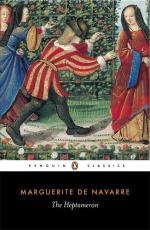In France, as everywhere else, prose fiction, like prose of all kinds, was considerably later in production than verse, and short tales of the kind before us were especially postponed by the number, excellence, and popularity of the verse fabliaux. Of these, large numbers have come down to us, and they exactly correspond in verse to the tales of the Decameron and the Heptameron in prose, except that the satirical motive is even more strongly marked, and that touches of romantic sentiment are rarer. This element of romance, however, appears abundantly in the long prose versions of the Arthurian and other legends, and we have a certain number of short prose stories of the thirteenth and fourteenth centuries, of which the most famous is that of Aucassin et Nicolette. These latter, however, are rather short romances than distinct prose tales of our kind. Of that kind the first famous book in French, and the only famous book, besides the one before us, is the Cent Nouvelles Nouvelles. The authorship of this book is very uncertain. It purports to be a collection of stories told by different persons of the society of Louis XI., when he was but Dauphin, and was in exile in Flanders under the protection of the Duke of Burgundy. But it has of late years been very generally assigned (though on rather slender grounds of probability, and none of positive evidence), to Anthony de la Salle, the best French prose writer of the fifteenth century, except Comines, and one on whom, with an odd unanimity, conjectural criticism has bestowed, besides his acknowledged romance of late chivalrous society, Petit Jehan de Saintre (a work which itself has some affinities with the class of story before us), not only the Cent Nouvelles Nouvelles, but the famous satirical treatise of the Quinze Joyes du Mariage, and the still more famous farce of Pathelin. Some of the Nouvelles, moreover, have been putatively fathered on Louis XI. himself, in which case the royal house of France would boast of two distinguished taletellers instead of one. However this may be, they all display the somewhat hard and grim but keen and practical humour which seems to have distinguished that prince, which was a characteristic of French thought and temper at the time, and which perhaps arose with the misfortunes and hardships of the Hundred Years’ War. The stories are decidedly amusing, with a considerably greater, though also a much ruder, vis comica than that of the Heptameron; and they are told in a style unadorned indeed, and somewhat dry, lacking the simplicity of the older French, and not yet attaining to the graces of the newer, but forcible, distinct, and sculpturesque, if not picturesque. A great license of subject and language, and an enjoyment of practical jokes of the roughest, not to say the most cruel character, prevail throughout, and there is hardly a touch of anything like romance; the tales




